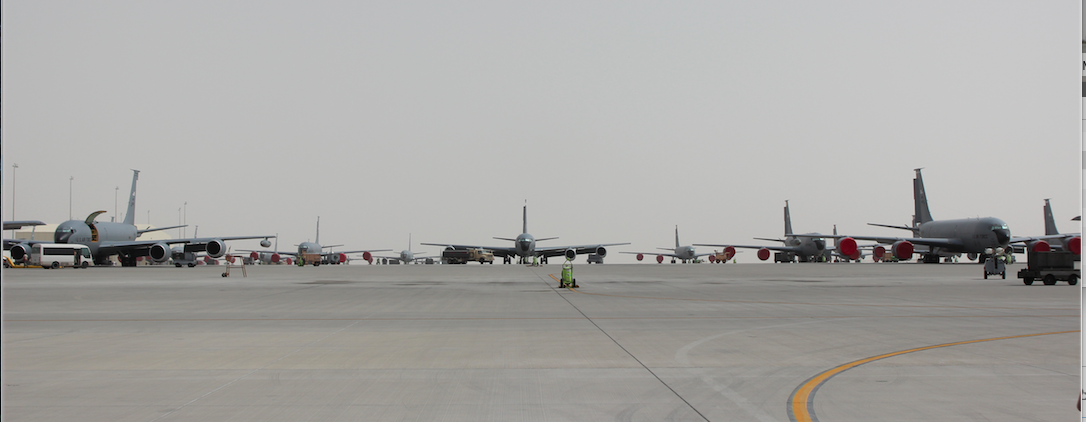
Several KC-135s sit on the flightline at the 379th Air Expeditionary Wing in Southwest Asia. Staff photo by Brian Everstine.
SOUTHWEST ASIA—On a recent afternoon at the Air Force’s biggest base in southwest Asia, a line of tankers waited to take off into the scorching air over the Persian Gulf.
The KC-135s from the 379th Air Expeditionary Wing at the undisclosed airbase had several missions. Some flew north to support the US-led coalition’s air war against ISIS, others east to refuel US fighters over Afghanistan. Even more headed south to refuel aircraft for the Saudi Arabian-led fight in Yemen or provide support for President Trump’s visit to Egypt that was taking place.
For mobility forces deployed to US Central Command, the ongoing “tanker war” of Operation Inherent Resolve is only a part of the massive tanking and airlift effort, and it all needs to be balanced by USAF officials both at home and in the nerve center of the Combined Air Operations Center.
“When you look at being expeditionary, there’s really nobody else who does this business the way we do it,” said Brig. Gen. John Williams, the director of mobility forces at the CAOC, in a recent interview with Air Force Magazine here. “… If you don’t have refueling support, you just can’t do the offensive operations we have. If you don’t have that, you aren’t supporting the troops in contact. It’s very much an important part of what happens over here.”
Williams is in charge of maintaining the current force of mobility aircraft and crews, especially the tanking force providing support for Inherent Resolve from three bases in the region. In 2016, US and coalition tankers flew 13,064 sorties, offloading 804 million pounds of fuel in 80,912 refuelings, according to statistics released by Air Forces Central Command.
Airlifters, including C-17s and C-130s based at this base in Southwest Asia, flew 46,900 passengers in 2016, and airlifted 72,800 short tons of cargo as part of the war against ISIS. Tankers and airlifters are both on pace to at least meet, if not surpass, those totals for 2017, all while operations in Afghanistan look to increase.
The plans to address this need are “changing all the time” with short-term strains, such as the May presidential visit or surges in operations.
It is “one of the games we play. Is there going to be a future requirement coming, and are we going to have forces ready for that?” Williams said.
Officials at the COAC work with the 618th Air Operations Center at Scott AFB, Ill., and the Central Command Deployment Distribution Operations Center to validate the lift requirement, and in turn work with US Transportation Command and Air Mobility Command to plan the number of tails and aircrews. In May, dozens of KC-135s lined the flightline at the 379th Air Expeditionary Wing, representing several bases across the US. But at times, that number might not be enough and more need to be requested.
“Obviously you’ve got your plan, and no plan survives contact with the enemy,” Williams said. “When something comes up you have to deal with it.”
At the 380th Air Expeditionary Wing at another base in a nearby country, about one fourth of the Air Force’s entire KC-10 Extender fleet is deployed and in daily operations. About 60 of the aircraft are ready, so “you can tell how important this mission is,” wing commander Brig. Gen. Charles Corcoran said in an interview.
Seven partner nations have been involved in the refueling effort for Operation Inherent Resolve, which brings “tremendous flexibility” when needed. There is a “small effort” for airlift, an effort that US officials would like to see grow to help address surge needs.
The airlift support provided at the 379th AEW and other bases in the region have been integral to US and allied operations, and have been available on demand.
“It’s a lifeblood of what happens around here,” Williams said. “If you don’t have tankers, you don’t have offensive air. You don’t have defensive air. You don’t have air. It’s all a part of that system. It’s gotta happen, or you’re sunk. And it takes a lot of adjustments, and it takes a lot of planning.”
